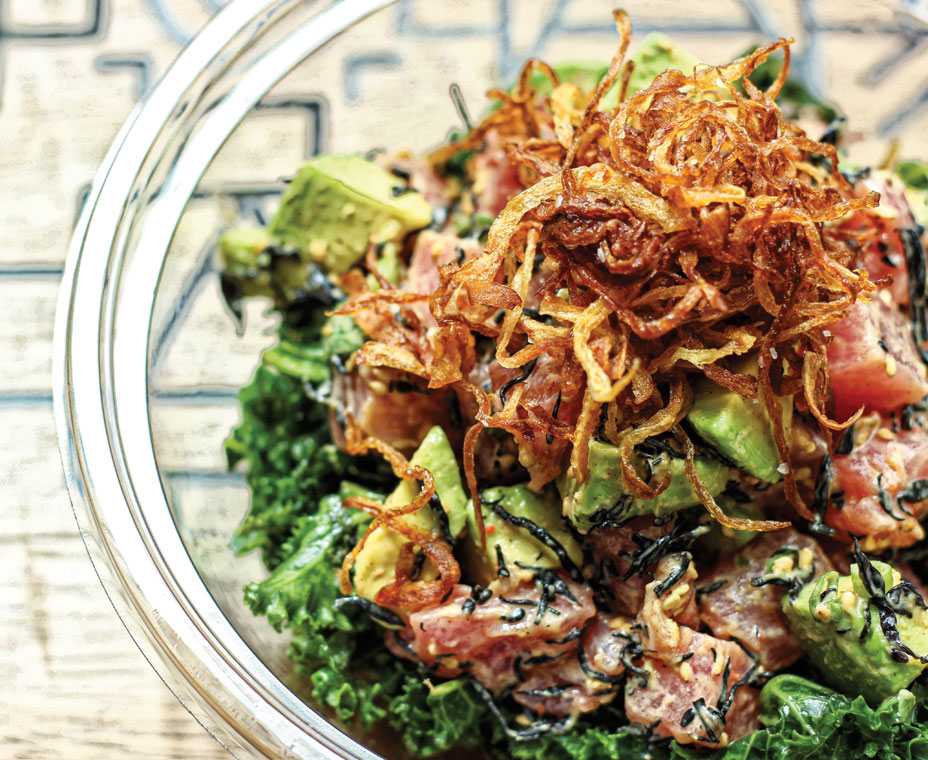Sushi can be expensive.
So say Brett Nestadt and Seth Cohen, two of the founders of fast casual Sweetfin Poké. The pair, along with Los Angeles restaurateur Alan Nathan, wanted to offer an alternative to the popular cuisine that wouldn’t break the bank for diners.
That led them to start the poké fast casual, which serves the Hawaiian staple of marinated raw fish in an accessible, customizable bowl format.
“We both love sushi. It’s something I would eat every night of the week if I could, but it’s a sit-down experience, and it’s not that affordable,” Nestadt says. “When we came upon the idea of selling poké, it had all the elements you love about sushi—high-quality raw fish, sauces, toppings—and when you put it in a bowl form and serve it at a fast-casual restaurant, you’re minimizing a lot of the overhead costs. You can bring the price down considerably to give someone the opportunity to have this meal a few times per week.”
Nestadt, Cohen, and Nathan founded the concept in 2015 and brought Dakota Weiss on as a partner and executive chef.
Sweetfin has already grown to six locations in the greater L.A. area since its founding, and Cohen and Nestadt say they will take a measured approach to future growth.
“We’ve had opportunities to go to other cities,” Cohen says. “We’ve had opportunities to franchise, which we’re not going to do. Everything we do at Sweetfin revolves around quality, from our food to our design to our employee training. For us, this is not a race. We’re trying to build a sustainable business, and we feel that owning our home base is our primary goal. Once we have our systems in place and we feel comfortable to take our concept to another city, we’ll do that.”
Even though the founders emphasize affordability—the average guest check is about $14 per person—they don’t skimp on quality.
Using Hawaiian poké as a starting point, Weiss incorporates ingredients that are rooted in Japanese cuisine. Sweetfin’s citrus sauce is made with imported yuzu kosho, a paste that combines citrus yuzu with chilies and salt. Dishes like the taro chips are spiced with other Japanese seasonings, like togarashi and wasabi furikake.
“When you go to Hawaii, you will see a lot of poké served out of deli counters where it’s pre-marinated in heavy sauces. At Sweetfin, we wanted to skew more toward a Japanese flavor profile that would be more similar to sushi in terms of flavor,” Cohen says. “We really focus on Japanese ingredients and then implement a lot of California produce, which we’re fortunate to have.”
Sweetfin has more than 30 fruits, vegetables, herbs, and spices that can be added to its poké bowls. Bases such as bamboo rice and kelp noodles also bolster the menu’s healthfulness. Fish on the menu varies by the season, but includes yellowfin tuna, salmon, snapper, and albacore, all of which are sourced sustainably.
Sweetfin Poké
FOUNDERS: Alan Nathan,
Brett Nestadt, & Seth Cohen
HQ: Los Angeles
YEAR STARTED: 2015
ANNUAL SALES: Undisclosed
TOTAL UNITS: 6
FRANCHISE UNITS: 0
Nestadt and Cohen both adhere to a healthy eating lifestyle, so it was important that the Sweetfin menu follow that same ethos. The entire menu is gluten free, although Nestadt points out that it wasn’t a forced consideration, but rather one that evolved naturally. The pair continue to tweak the menu by watching trends and following seasonality.
Each location also has its own full-time chef who oversees food handling. The chefs also have the freedom and opportunity to take creative license with local ingredients and new flavor combinations
Unlike some assembly-line models, dishes are prepared by line cooks and not along a station in front of the customer. Because Sweetfin’s menu comprises raw fish and very fresh ingredients, Nestadt says, it was imperative that everything was very hygienic and temperature-controlled.
“Instead of a cashier or someone going down the line and putting ingredients in, our chef is overseeing line cooks who are making your food,” he says. “You might not see it, but the reason behind that isn’t because we’re trying to hide anything; we’re trying to keep our ingredients as safe and contained as possible.”
Nestadt calls the restaurant design “surf-chic,” since it’s inspired by the stores’ proximity to the ocean, as well as Malibu beach houses with whitewashed wood. Design elements are specific to each location and reflect the unique character of each neighborhood.
Sweetfin chefs also get involved in local communities; they shop at farmers’ markets and create dishes from local produce.
Poké may be the latest fast-casual darling, as the cuisine continues to boom, but Nestadt and Cohen are confident that Sweetfin’s values will set the brand apart.
“Even though there are a lot of concepts opening up in the poké space, we don’t think that it’s a fad by any means. We believe that this is the next way in which consumers are going to eat sushi,” Cohen says.
“As long as we’re focusing on quality and transparency in our ingredients and great branding and store design, we don’t feel like we need to be first to market in every single city.”
This story originally appeared in QSR’s March 2017 issue with the title “Ones to Watch: Sweetfin Poké.”











